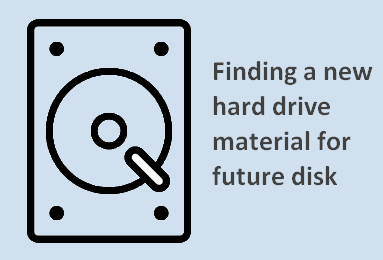As far as I know, almost all the hard disk drives currently adopt the magnetic storage to store and retrieve digital data on one or more disks/platters which are rotating rapidly and coated with magnetic material. Now, the researches discover a new viable recording material that may be used in the future.
The traditional hard disk drives are made up of several rapidly rotating platters which are coated with magnetic material. Matched with the magnetic heads, the platters are located on a moving actuator arm to read & write data to the surface. That is how data are stored on a traditional hard disk drive.
Click here if your hard drive crashes suddenly.
Yet, recently, a new hard drive material is found out by some researchers. And this new viable recording material may change the future hard disk drive.

New Hard Drive Material Comes Is Discovered
As is known to all, the magnetic recording is always the primary technology for hard drive storage (large-scale data storage). But things have changed in recent years; more and more companies start to spend time finding new materials for hard disk drives, hoping to break the recording densities limit of current hard drive (1 terabit per square inch).
New Material vs. Traditional Material
Traditional PMR:
Actually, the conventional Perpendicular Magnetic Recording (PMR) store data as tiny areas of up/down magnetization (which happens in a thin layer on the disk surface). Each of the tiny area stands for one bit of information. Thus, a reduction in bit size is necessary if anyone would like to increase the areal density.
SMR HDD Technology Increases Disk Density.
That is to say, as a traditional magnetic recording medium relying on the perpendicular cobalt-chromium-platinum (CoCrPt) oxide granular films, the PMR has already reached its limit in storage space. The limit is about 750 gigabits per square inch and it is reached since the thermal fluctuations will stop anyone from reducing the grain size below 6 ~ 7 nanometers.
New Viable Recording Material:
According to AIP Publishing, the L10 phase/crystallographic orientation of an iron and platinum (FePt) alloy has been adjusted by some Indian researchers as a solution to break through the recording densities limit that traditional materials have face.
Yet, the L10 phase of the FePt alloy is not so ideal till now. It is not compatible with the common industrial process since a pretty high annealing temperature is required. Besides, it will lead to the following desirable things:
- The growth of significant grain
- The increase of bit size
- …
However, if the ordering temperature can be lowered below 300 degrees centigrade, the transformation rate of L10 in FePt systems will be improved greatly. This is a major step to make L10 FePt the future hard disk material with high density perpendicular recording.
Status of the New Hard Drive Material
It is possible that L10 FePt will be able to increase the magnetic recording density of hard disk drives in the future so as to break the 1 terabit per square inch limit. It is said that one of the main challenges has been conquered through the reduction in the ordering temperature. However, key requirements like desired grain orientation must be met before the L10 FePt can finally be used.
It is said that the group of Indian researchers are seeking for a better understanding of the atomic-level mechanism due to the following reasons:
- They want to improve the L10 transformation rate in FePt.
- They want to optimize the multilayer structure’s layer composition & thicknesses.
- They want to make the peak enhancement come true.
- …
The researchers are studying the desired grain orientation and selecting the proper under layer of material (that will be deposit FePt). Their ultimate goal is to generate the perpendicularly magnetized storage media for future hard drive.

User Comments :